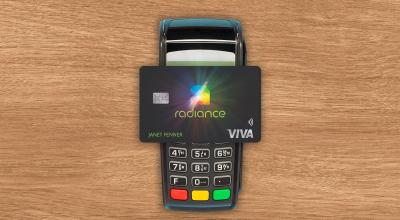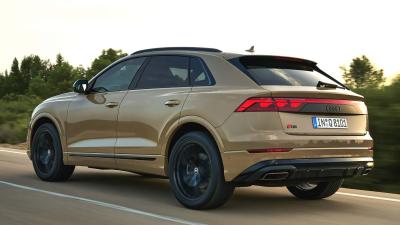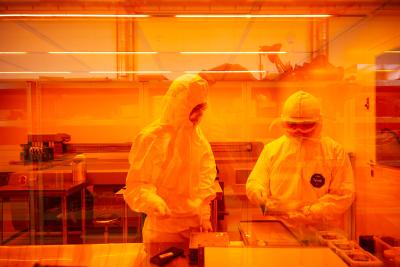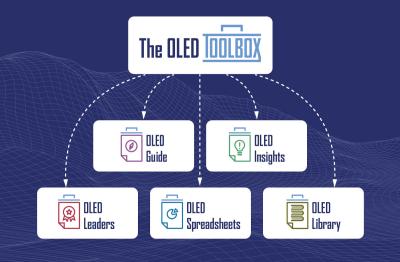OLED (Organic Light Emitting Diodes) are light emitting panels made from organic (carbon based) materials that emit light when electricity is applied. OLED displays are popular today in smartphones, laptops, wearables, TVs, and more - but these panels can also be useful for lighting purposes.
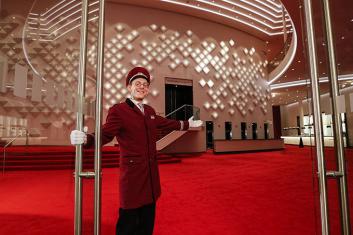
An OLED 'light bulb' is a thin film of material that emits light. OLED is the only technology that can create large "area" lighting panels (as opposed to point or line lighting enabled by LEDs and fluorescent bulbs). OLEDs can be used to make flexible and transparent panels, and can also be color-tunable. OLEDs emit beautiful soft diffused light - in fact OLEDs lighting is the closest light source to natural light (with the exception of the old incandescent lamps).
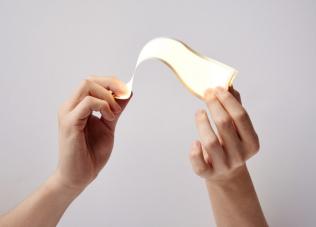
The OLED lighting market
OLED is an amazing technology for lighting - it creates beautiful, efficient and healthy light sources. OLED lighting has great promise but unfortunately the high price of production is a challenge that no one has managed to overcome and OLED lighting remains a small niche industry as of 2024.
In the early years, several large lighting makers (including GE, Philips, OSRAM, LG, Konica Minolta, Panasonic, NEC and others) had active OLED lighting programs, but slowly almost all of these companies dropped out of the market - for various reasons - but the main one being that the large investments in large scale production are not certified to lead to market adoption and the competition with LED lighting is extremely difficult.
But not all is lost. Konica Minolta is now mass producing OLED lighting panels, and OLEDWorks (which took over Philips' OLED lighting fab in Germany) is making excellent progress with automotive OLED lighting. China-based Yeolight is building $100 million OLED lighting fab, and Germany's Inuru is targeting niche markets with its printed OLEDs.
Further reading
- An introduction to OLEDs
- OLED Technology explained
- Transparent OLEDs
- Flexible OLEDs
- The OLED Toolbox, our comprehensive OLED industry information resource
Sentry announced it has ordered a substantial number of Konica Minolta's OLED panels for its Radiance platform
A couple of months ago fintech company Sentry launched the Radiance card illumination platform, which enables credit card (and other payment card) issuers to offer a unique experience by using an OLED lighting panel embedded in the card.
Today the company announced that it has placed the first substantial commercial order for the OLED units from Konica Minolta. The Radiance card platform works without a battery, and the OLED panel is powered by the NFC receiver upon a transaction (a technology that was demonstrated by KM back in 2020).
OLEDWorks confirms it is supplying the OLED lighting panels for Audi's 2024 Q8 SUV
In 2023, Audi unveiled the 2024 Q8 and SQ8 SUVs, which sports optional OLED taillights, similar to the ones used in the 2022 Audi A8. We assumed that the OLED panels were supplied OLEDWorks, and the company indeed formally confirmed that the 2024 A8 uses its Atala OLED technology.
The Q8 uses Audi's first-gen design, as it was in the 2022 A8. A total of six panels—each less than one millimeter thick—span the rear of the car. One panel occupies each of the left and right bodyside lamps, and four panels span the continuous inner tailgate lamp. Every panel contains six high-contrast segments that are individually addressable via software control.
Sentry Enterprises launches an illuminated credit card platform with a flexible OLED lighting panel produced by Konica Minolta
In 2014 Konica Minolta started constructing its groundbreaking R2R flexible OLED lighting fab. The project saw many delays and entered production later than planned, and KM started producing panels at low volume at around 2020. The company recently started to ramp up production, and today we hear of one of its first customers and partners, Sentry Enterprises.
Sentry, a fintech company, launched the Radiance card illumination platform, which enables credit card (and other payment card) issuers to offer a unique experience by using an OLED lighting panel embedded in the card. The OLED panel is produced by Konica Minolta. The card works without a battery, and the OLED panel is powered by the NFC receiver upon a transaction (a technology that was demonstrated by KM back in 2020).
The 2025 Audi SQ7 SUV to feature OLED taillights
Audi unveiled its 2025 Q7 and SQ7 SUVs, with the latter offering the company's 2nd-gen OLED taillights. It is not clear whether these will be standard or optional.
Audi did not detail much about these OLED taillights - but these are likely to be similar to the ones used in the new Q6 e-tron, which uses a total of 360 individual OLED panels built into 6 different lighting panels (each made from 60 OLED panels, or segments as Audi calls them).
Audi releases a video showing the Q6 e-Tron OLED taillights
In July 2023, Audi unveiled the upcoming 2024 Audi Q6 e-tron, with its second-gen OLED taillight technology. The new taillight lighting system use a total of 360 individual OLED panels built into 6 different lighting panels (each made from 60 OLED panels, or segments as Audi calls them), and is able to show warnings and signals to other drivers. Audi now released a nice video showing the new OLED taillight modules in action:
Audi will ship the cars with 8 pre-configured digital light signatures, and customers will be able to add their personal light signatures using the myAudi app. The OLEDs are likely produced by OLEDWorks, like all of Audi's recent OLED panels.
Inuru inaugurates its inkjet printing OLED lighting production line in Wildau
Germany-based OLED lighting developer Inuru inaugurated its new OLED lighting panel production line, the "Dragon Factory", in Wildau near Berlin, Germany. This is an important milestone for Inuru, which is focusing on medication packaging and entertainment applications. The production line is now ready, but it will probably take some time to ramp-up and achieve full-scale production.
Inuru produces its OLED lighting panels using an inkjet printing process, which it says educes production costs by around 90% compared to conventional (evaporation-based) processes.
OLED-Info launches The OLED Toolbox, a revolutionary information product for the OLED industry
We are happy to launch The OLED Toolbox, a new information product for the OLED industry that provides an unprecedented depth of OLED content, data, analysis and insights, written and compiled by the industry's leading portal, OLED-Info.com.
The OLED Toolbox presents an unparalleled array of resources, including guides, projections, analyses, and profound insights into the world of OLED displays and lighting. Never before has it been so easy to gain access to a complete OLED industry resource!
What you'll find inside
- OLED Guide: an expert guide to OLED technologies, the OLED market and the OLED industry, covering everything you need to know about OLEDs
- OLED Insights: OLED analysis and insights, covering all the latest and future trends and developments in the OLED industry
- OLED Spreadsheets: excel files with detailed information on the OLED market and industry (including OLED devices, fabs, microdisplays, automotive solutions and more)
- OLED Leaders: In-depth articles by leading OLED professionals to discuss industry and market topics
- OLED Library: Over 160 content items by industry players - brochures, catalogs, roadmaps, presentations and more.
Researchers develop a perovskite-based 3D printing ink that could power next generation OLED devices
Researchers at Lawrence Berkeley National Laboratory (Berkeley Lab), led by Prof. Peidong Yang, developed a new 3D printing ink based on perovskite materials, that exhibits unity photoluminescence quantum yield (PLQY). Interestingly, as it is a 3D printable ink, it is possible to create luminescent objects from it, as seen in the image below:
The researchers brand the new ink as 'supramolecular ink', and say it is produced without any rare metals. It is a combination of several powders containing hafnium (Hf) and zirconium (Zr), and is made at room temperatures. In a process called supramolecular assembly, tiny molecular building block structures are self-assembled within the ink. These supramolecular structures enable the material to achieve stable and high-purity synthesis at low temperatures.
OLEDWorks announces Atala - a new automotive OLED lighting brand
US-based OLED lighting developer OLEDWorks seems to be focusing on automotive OLED lighting solutions for the last few years, and the company now announced a separate brand for automotive OLED lighting - Atala.
OLEDWorks explains that the new brand will support a line of automotive qualified OLED lighting products designed specifically for Tier 1 suppliers and original equipment manufacturers (OEMs). The name Atala originates from an acronym for advanced technology for automotive lighting applications.
An interview with Pixelligent's CEO, to discuss the company's technology and latest OLED industry updates
US-based Pixelligent is an advanced materials company that delivers next generation optical materials applications in lighting and displays. For the OLED industry, Pixelligent offers materials that significantly increase light output by increasing the refractive index of materials in the device.
Pixelligent's President and CEO, Craig Bandes, was kind enough to answe a few questions we had, to learn more about Pixelligent and its solutions for the OLED industry.
Hello Craig! Can you explain your technology and materials and how they enhance the efficiency of OLED display?
We are best known for our high refractive index (HRI) nanocrystal formulations and dispersions that deliver breakthrough performance in next-generation electronics, like extended reality, displays, optics, and sensors. We designed our PixJet®, PixNIL®, and PixClear® products to offer the best combination of brightness, clarity, operating efficiencies, and device-lifetime.
Pagination
- Page 1
- Next page
